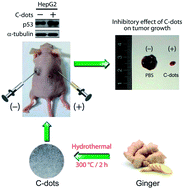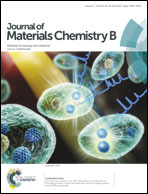Carbon dots prepared from ginger exhibiting efficient inhibition of human hepatocellular carcinoma cells†
Abstract
Fluorescent carbon nanodots (C-dots; 4.3 ± 0.8 nm) from fresh tender ginger juice provide high suppression of the growth of human hepatocellular carcinoma cells (HepG2), with low toxicity to normal mammary epithelial cells (MCF-10A) and normal liver cells (FL83B). The inhibition is selective to HepG2 over other tested cancer cells, including human lung cancer cell line (A549), human breast cancer cell line (MDA-MB-231), and human cervical cancer cell line (HeLa). Western blot results reveal that the C-dots up-regulate the expression of p53 protein only in the HepG2 cell line. The 50% inhibiting concentration (IC50) value of the C-dots on HepG2 cells is 0.35 mg mL−1. Image cytometry results show significant uptake of C-dots by HepG2 cells that induce intracellular production of reactive oxygen species (ROS, 18.2-fold increased), while other cells remain almost the same in ROS levels after treatment with C-dots (1.11 mg mL−1). The C-dots trigger the pro-apoptotic factor to promote HepG2 cell apoptosis. The C-dots effectively inhibit the growth of tumors in nude mice (104 ± 14 vs. 3.7 ± 0.2 mg with and without treatment within 14 days).


 Please wait while we load your content...
Please wait while we load your content...